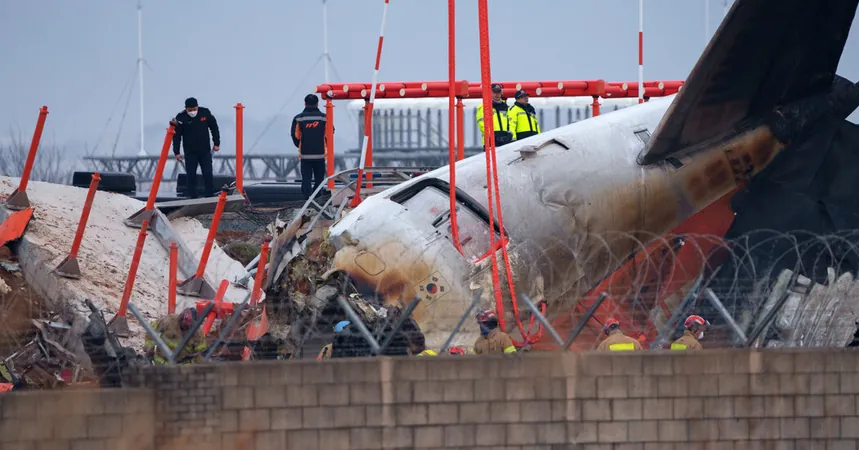
Tragic Jeju Air Flight 2216: Final Minutes Revealed Prior to Catastrophic Crash
2025-04-08
Author: Yan
Background of the Incident
In a shocking revelation, the pilots of Jeju Air Flight 2216 outlined three possible landing strategies in the harrowing final moments before the aircraft tragically crashed on December 29, resulting in the loss of 179 lives.
A partial transcript of their communication with air traffic controllers, recently obtained by The New York Times, sheds light on the desperate situation faced by the crew as they approached Muan International Airport in South Korea.
Initial Emergency Response
Initially, the pilots reported a bird strike shortly after 8:58 a.m., issuing a mayday call as they grappled with their aircraft.
They attempted a left turn for an approach to the airport's only runway but quickly sought permission to turn right instead.
When that maneuver failed, controllers suggested landing from the opposite direction.
The Crash and Consequences
Tragically, all attempts to safely land the Boeing 737-800 were unsuccessful.
The airplane ultimately landed belly-first, overran the runway, collided with a concrete structure housing navigation aids, and ignited into a massive fireball.
Strikingly, only two flight attendants on board survived this catastrophic event.
Investigation and Findings
The investigation into what is now deemed the deadliest plane crash in South Korean history is ongoing, with authorities examining various factors that may have exacerbated the situation.
One critical aspect remains the malfunctioning black boxes, which, alarmingly, ceased recording data approximately a minute before the crash occurred.
This blackout has left investigators scrambling for answers, as both the flight data recorder and cockpit voice recorder failed to capture essential final exchanges.
Eyewitness Accounts
Eyewitness accounts and video footage taken by bystanders are now pivotal in piecing together the catastrophe.
Notably, the pilots acknowledged the presence of birds shortly before the crash, with authorities later discovering evidence of migratory ducks—specifically, baikal teals—found in the plane's engines, suggesting severe engine distress.
Expert Opinions
Hyoseok Chang, an air transportation expert at Hanseo University, emphasized that in cases of engine failure, standard protocol typically requires the aircraft to ascend to a safe altitude, entering a holding pattern.
However, time was running out, and less than a minute after reporting the bird strike, the pilots expressed urgency in their landing preparations.
Landing Attempts and Final Moments
Attempts to land on Runway 1 from the south ultimately failed, prompting the pilots to ask about a potential landing from the north instead, known as Runway 19.
Unfortunately, even this modified approach proved disastrous.
In a tragic turn of events, the aircraft made contact with the ground without deploying its landing gear, skidded off the runway, and crashed into a solid concrete structure—designed to support navigation systems but not built to collapse on impact, despite international safety standards.
Ongoing Investigations
Authorities are now conducting multiple investigations into the incident, with collaboration from American and French aviation experts.
As families of the victims mourn their losses, more questions than answers remain surrounding the operational conditions of the aircraft, the extent of its mechanical failures, and the critical choices made by the pilots in their desperate struggle to land safely.
Conclusion and Future Updates
Stay tuned as we continue to follow this tragic story and unpack the details of the ongoing investigation that holds the key to understanding this heartbreaking aviation disaster.



 Brasil (PT)
Brasil (PT)
 Canada (EN)
Canada (EN)
 Chile (ES)
Chile (ES)
 Česko (CS)
Česko (CS)
 대한민국 (KO)
대한민국 (KO)
 España (ES)
España (ES)
 France (FR)
France (FR)
 Hong Kong (EN)
Hong Kong (EN)
 Italia (IT)
Italia (IT)
 日本 (JA)
日本 (JA)
 Magyarország (HU)
Magyarország (HU)
 Norge (NO)
Norge (NO)
 Polska (PL)
Polska (PL)
 Schweiz (DE)
Schweiz (DE)
 Singapore (EN)
Singapore (EN)
 Sverige (SV)
Sverige (SV)
 Suomi (FI)
Suomi (FI)
 Türkiye (TR)
Türkiye (TR)
 الإمارات العربية المتحدة (AR)
الإمارات العربية المتحدة (AR)